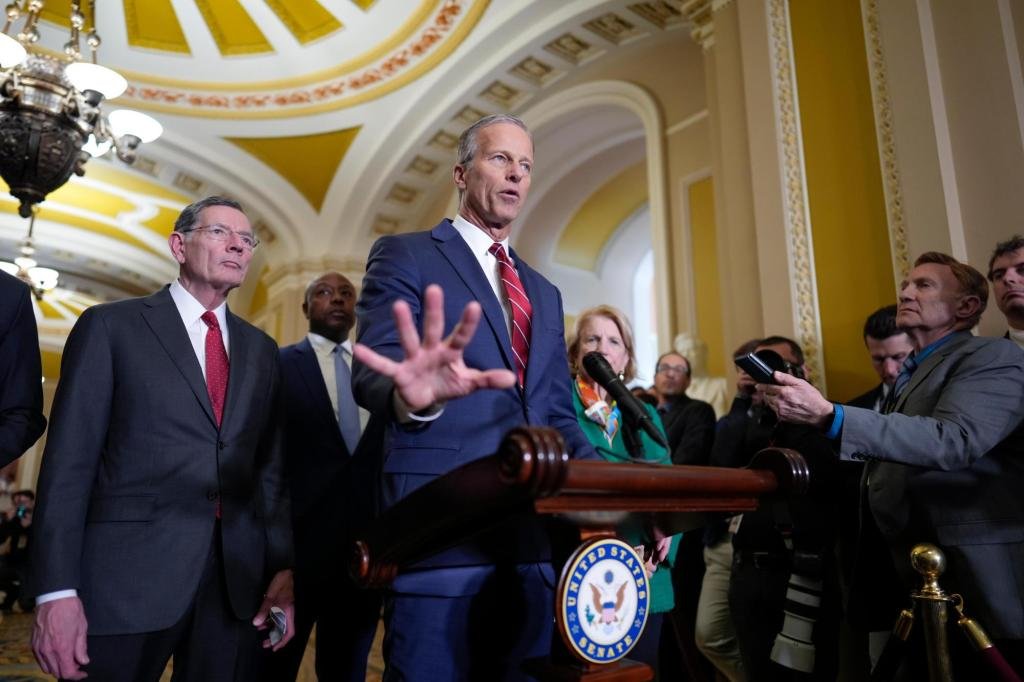Title: Republican Senators Collaborate with Trump on Tax Cuts and Budget Framework: Key Insights and Predictions
Introduction:
In a pivotal moment for U.S. economic policy, Republican senators convened with President Donald Trump to discuss an ambitious plan for tax breaks and spending cuts. This meeting emphasizes the urgency for legislators to navigate complex issues surrounding funding and cost implications for a proposed multitrillion-dollar package. As GOP leaders aim to establish a budget framework that aligns with the House Republicans’ extensive $4.5 trillion tax cuts proposal, they are strategically postponing critical decisions to accelerate progress. This article provides an overview of the key elements from this political development, exploring its implications for American taxpayers and federal spending.
The Push for a Unified Budget Framework:
Senate Majority Leader John Thune expressed optimism about reaching a budget resolution that would facilitate the proposed economic package. This framework, which proposes substantial tax cuts alongside significant spending reductions, represents a critical alignment between the Senate and the House Republicans. The plan emphasizes extending tax cuts established during Trump’s initial term, with the goal of not only preventing expiration but also expanding these provisions to include exemptions on various wage types. The overarching objective is to solidify support for a fundamental aspect of Trump’s domestic policy agenda as the administration seeks to bolster economic growth ahead of the upcoming elections.
Democrats’ Opposition and Concerns:
Democrats are gearing up for a formidable pushback against the GOP tax proposals, labeling them as primarily benefiting the wealthy while jeopardizing essential public services. Prominent Democratic figures, including House Leader Hakeem Jeffries, have publicly denounced the proposals, characterizing them as detrimental to millions of American families who rely on government programs. The contention revolves around fears that significant cuts to services—particularly in healthcare—will follow the implementation of vast tax breaks, potentially widening socioeconomic disparities among citizens. As legislation progresses, this partisan divide underscores the contentious nature of tax policy reform in the U.S. Congress.
Debate Over Cost Offsets:
At the heart of the disagreement between House and Senate Republicans lies the fundamental question of financing the proposed tax cuts. The House GOP insists that any extension of the existing cuts, projected to reduce federal revenue by $4.5 trillion over the next decade, necessitates reductions in other spending areas—particularly in healthcare. In contrast, Senate Republicans argue that existing tax cuts should be considered part of the current policy landscape and thus exempt from additional funding requirements. They seek to create a compromise that prioritizes immediate action while delaying more comprehensive fiscal assessments. However, this strategy has drawn criticism from Senate Democrats, who argue that it misrepresents the reality of the budget’s long-term implications.
Implications for Federal Deficits and Services:
If implemented, the GOP’s framework could have far-reaching consequences for federal deficits and public services, raising the specter of increased financial strain on government programs. Critics, including Democratic senators like Cory Booker, have labeled the proposed tax cuts as a mere facade for enhanced fiscal pressure on federal services, warning of a future marked by diminished support for critical programs. The anticipation of growing deficits poses a significant concern for policymakers, as the burden of funding government programs shifts amidst vast cuts in revenue. This ongoing debate will undoubtedly alter the narrative surrounding fiscal responsibility and prioritize competing interests in American governance.
The Road Ahead: Immediate Steps and Legislative Challenges:
As GOP leaders aim to finalize their proposed budget framework, they face the urgent challenge of navigating procedural hurdles within the Senate. The proposed current policy baseline approach, which Senate leaders believe does not require the approval of the Senate parliamentarian, is crucial for expediting progress on their agenda. This determination to advance swiftly demonstrates the urgency felt by Republican lawmakers in building momentum before potential election-related ramifications surface. The process involves extensive negotiations and deliberations, with indications that a lengthy all-night vote could serve as a critical juncture for shaping future policy discussions.
Conclusion: A Complicated Path Forward:
The current trajectory of U.S. tax policy highlights profound divisions within Congress and the intricacies of managing legislative goals amid widespread public scrutiny. As Republican senators and President Trump strategize to solidify a cohesive budget framework, the interplay between tax cuts and government investment remains a contentious point of debate. With Democratic leaders emphasizing the potential adverse effects of the proposed measures, the successful passage of any significant tax reform remains uncertain. Policymakers must tread carefully, balancing the pursuit of a unified economic vision with the broader implications for constituents across the nation. In the coming weeks, the political landscape may shift further, as both parties work to assert their positions while safeguarding the financial health of the American economy.





